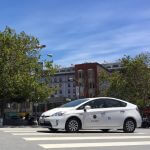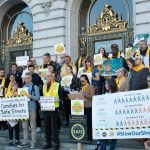What congestion pricing could mean for San Francisco… and who must shape it
What if San Francisco could simultaneously improve air quality and traffic safety in the most impacted neighborhoods, plus boost Muni service and affordability while also fighting climate change?
This is the potential of congestion pricing – charging a fee to drive into or within downtown areas – if it’s done right. Cities like London, Stockholm, Milan, and Singapore have already embraced congestion pricing.
At Walk San Francisco, we see congestion pricing as a promising solution, especially when it comes to ending severe and fatal traffic crashes on our streets. If you look at cities within reach of Vision Zero, congestion pricing is one of the most effective tools at play.
Yet congestion pricing is a non-starter unless it’s designed with equity on all fronts. In 2019, before the San Francisco County Transportation Authority (SFCTA) got the green-light to study a potential congestion pricing program, Walk SF began looking at what it could mean for communities bearing the burden of transportation inequities.
With the support from the William and Flora Hewlett Foundation and Natural Resources Defense Council, we held 13 outreach sessions in the Tenderloin, South of Market, and Bayview Hunters Point to talk with residents in these neighborhoods about two key questions: what are your biggest concerns about a potential congestion pricing program, and what would you most want to invest funds from congestion pricing in?
What we heard is only a small sampling of the voices that need to be at the heart of SFCTA’s planning process. But what rose to the top in our outreach is that: 1) who will pay the full toll is the biggest area of concern; and 2) more affordable and more frequent transit service are the top priorities for investment.
I’ll be presenting Walk SF’s findings in much more detail to the full SFCTA Board on Tuesday, October 27th. You can read the full report my presentation is based on.
There’s one comment from a participant that particularly stuck out in what we heard. It was that congestion pricing should only be implemented if it will meaningfully improve the lives of the many communities it is meant to serve – not to make marginal improvements or backfill programs that should be happening regardless.
This conversation is an incredibly important one for our city to have, and specifically who is part of those conversations is at the heart of the matter. Walk SF will continue to shape the SFCTA’s study as part of the Policy Advisory Committee, and do the needed outreach to the Tenderloin, Bayview and SoMa neighbors who must be at the table in shaping this policy.
Thanks to our Vision Zero Organizer Brian Haagsman and outreach assistant Cole Brennan for their stellar work in conducting the outreach, data collection, and analysis used to write this report.




